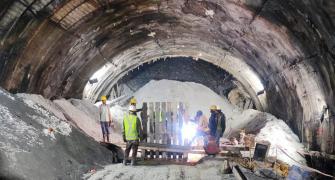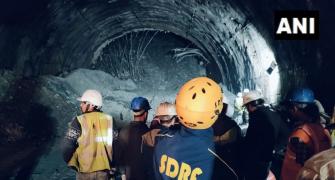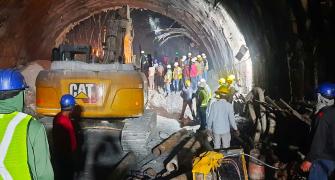Rescue workers had bored through 24 metres of rubble at a collapsed tunnel here up to Friday evening, less than half the stretch of debris blocking the way to the 40 workers trapped inside for more than five days.

Equipment similar to the 25-tonne American-made machine now in operation was also being flown in from Indore as “backup” for the rescue operation at the under-construction Silkyara tunnel on the Char Dham route in Uttarakhand.
An official from the National Highways & Infrastructure Development Corporation, the company tasked with the construction of the tunnel, dismissed reports that rescue work was being hampered by technical problems with the American auger machine.
The machine from Indore was only for backup for it so that the rescue work continues uninterrupted, he told reporters.
The “state-of-the-art” machine was earlier said to have a capacity of drilling up to four or five metres per hour. But the operation so far has progressed at the rate of less than a metre an hour since its deployment Thursday morning.
The workers are trapped beyond a 60 metre-stretch of rubble and being sent food, water and medicines through pipes. There is constant communication with them, officials said.
The plan is to insert six-metre sections of steel pipes one after the other as the machine drills through the rubble. Each pipe has a diameter of 800 or 900 mm.
The fifth pipe was being inserted Friday evening.
Asked why the machine had not reached the “expected” rate, National Highways & Infrastructure Development Corporation Limited director Anshu Manish Khalkho told reporters that aligning the pipes and welding them before pushing through the debris takes time.
The operation has to be put on pause every now and then, Khalkho said while alluding to fumes created by the diesel-driven machine in a close environment and vibrations created in the tunnel due to the drilling.
He said the machine has been working satisfactorily and its speed will go up as rescue workers get accustomed to the process.
Another auger machine which was being airlifted from Indore is only for backup so that the rescue work continues uninterrupted, he said. But he maintained that there was no problem with the one now in operation.
Asked if vertical drilling to rescue the workers was also being considered, Khalko said a survey for this was being conducted.
However, the horizontal drilling being carried out now was the best option as an earlier survey had indicated that the other method could lead to more debris.
Relatives of the trapped workers and officials from their home states have been coming to the rescue site, and allowed to speak to them through a pipe that runs through the rubble.
"My nephew is among those trapped. I spoke to him. He said that he was fine," Uttar Pradesh resident Shatrughan Lal said.
A man from UP's Lakhimpur Kheri too spoke to his son. "He asked me not to get tensed up as he is doing well. The authorities have asked us to wait patiently. All I wish is that he comes out safely."
Navayuga Engineering Company spokesperson told PTI, "The trapped workers have been provided food. They are fine. The auger machine is also working well. We pray to God that they are evacuated as soon as possible."
The American auger machine was flown in from Delhi on Wednesday on IAF's Super Hercules planes in separate parts and later assembled at the site. It replaced the earlier drilling equipment as that had the capacity to penetrate only up to 45 metres of rubble, Adesh Jain, an expert involved in the operation, said.
In turn, it had to be replaced by the heavier and more efficient machine as the debris had later spread over a stretch of about 70 metres, according to Jain.
The “backup” machine was being flown to Dehradun's Jolly Grant airport by the IAF's C-17 Globemaster aircraft, much bigger than the Super Hercules planes that brought the equipment now in use.
The round-the-clock rescue work is being carried out by 165 personnel from multiple agencies, including the National Disaster Response Force, State Disaster Response Force, Border Roads Organisation and the Indo-Tibetan Border Police, the State Emergency Operation Centre said.
The stretch where the stretch of fallen rubble begins is 270 metres from the mouth of the tunnel on the Silkyara side.










